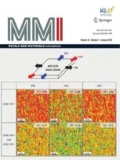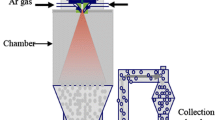Abstract
To investigate the effect of the powder synthesis atmosphere on the characteristics of iron nano powder in a plasma arc discharge process, the hydrogen volume fraction in the powder synthesis atmosphere was changed from 10 to 50%. The particle size, phase structure, and magnetic property of the synthesized iron powder were studied using FE-TEM, XRD, XPS, and a vibration sample magnetometer at room temperature. The particle size increased simultaneously with the increase in the hydrogen volume fraction, and the particle size ranged from about 20 to 100 nm with the change in the hydrogen volume fraction from 10 to 50%. The synthesized iron powder particles had a two-layered shell-core structure composed of α-Fe in the core, Fe3O4 in the inner shell, and FeO(OH) in the outer shell. The thickness of the oxide shells decreased with increasing hydrogen volume fraction in the powder synthesis atmosphere.
Similar content being viewed by others
References
R. W. Siegel,Mater. Sci. Eng. A 164, 189 (1993).
Y. Fukano.Jpn. J. Appl. Phys. 13, 1001 (1974).
M. Kusunoki and T. Ichihashi,Jpn. J. Appl. Phys. 25, 219 (1986).
B. K. Kim, G. G. Lee, G. H. Ha, and D. W. Lee,Metals and Materials 5, 109 (1999).
K. E. Gonsalves, S. P. Rangarajan, and J. Wang,Handbook of Nanostructured Materials and Nanotechnology (ed, H. S. Nalwa), p. 1, Academic Press, London (2000).
Y. Sakka and S. Ohno,Appl. Surf. Sci. 100–101, 232 (1996).
H. Li, H. Yang, G. Zou, and S. Yu,Adv. Mater. 9, 156 (1997).
P. M. Kumar, C. Balasubramanian, N. D. Sali, S. V. Bhoraska, V. K. Rohatgi, and S. Badrinarayanan,Mater. Sci. Eng. B 63, 215 (1999).
F. Brochin, X. Devaux, and H. Scherrer,Nanostruct. Mater. 11, 1 (1999).
D. R. Askeland,The Science and Engineering of Materials, p. 169, PWS Engineering Boston (1984).
D. Y. Kim and I. Y. Go,Plasma Metallurgy, p. 390, Bando, Seoul (1997).
M. Uda,Bull. Metal. Soc. Japn. 22, 412 (1983).
D. Y. Kim and I. Y. Go,Plasma Metallurgy, p. 186, Bando, Seoul (1997).
M. Cohen,Introduction to Magnetic Materials, p. 383, Addison-Wesley Publishing Company, New York (1972).
D. L. Leslie-Pelecky and R. D. Rieke,Chem. Mater. 8, 1770 (1996).
Author information
Authors and Affiliations
Corresponding author
Rights and permissions
About this article
Cite this article
Lee, GG., Kim, WY. Effect of powder synthesis atmosphere on the characteristics of iron nanopowder in a plasma arc discharge process. Met. Mater. Int. 11, 177–181 (2005). https://doi.org/10.1007/BF03027463
Issue Date:
DOI: https://doi.org/10.1007/BF03027463




